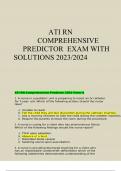Summary
Summary GDL - UNIVERSITY OF LAW - CRIMINAL LAW - FULL REVISION NOTES WITH ESSAY PLANS (DISTINCTION)
- Module
- Criminal Law
- Institution
- University Of Law (ULaw)
Scored a 75 in the 2022 exam using these notes. These notes contain the structure for answering all criminal law questions on the GDL at ULaw. They also include essay plans/answers to all possible criminal law essay questions.
[Show more]












